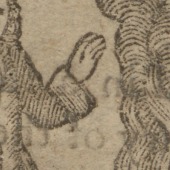London: Ryle & Co., [18–]
The story of George Barnwell, who robbed and killed his uncle to fund his relationship with a prostitute, was one of the most popular of the nineteenth century, though when Barnwell lived is difficult to say. His tale is first recorded as a ballad in the 1650s, and in 1731 was turned into a play, The London Merchant; it was staged almost 100 times in its first ten years and was printed in as many editions by the end of the century. At about the time this edition was printed, the essayist Charles Lamb drew attention to the strong moral tone of the story, calling it “a nauseous sermon”.
CCD.7.50.1, pp. 6–7
London: Ryle & Co., Printers, 2 & 3 Monmouth Court, Seven Dials [18–]
The story of George Barnwell was one of the most popular of the period, though when Barnwell lived is difficult to say. The story is first recorded as a ballad in the 1650s, and in 1731 was turned into a play called The London Merchant. It was staged almost 100 times in its first ten years, being performed on several occasions for King George II and Queen Caroline, and by the end of the century had been printed in as many editions.
After living with a wealthy uncle for three years, George began work in Cheapside, and was trained in the ways of finance. In these early years he was punctual and hard-working, to a degree “rarely attained by persons of his age and experience.” Just as he was about to be betrothed to the daughter of his master, he encountered a young woman named Sarah Milwood and was tempted into a life of vice. To provide for this woman, described variously as a “siren” and “base wretch”, Barnwell robbed his master and eventually shot dead his uncle to take his fortune. The story ends with Milwood having him arrested to save herself from being implicated, after which he was hung.
At about the time the edition shown here was printed, the essayist Charles Lamb drew attention to the strong moral tone of the story, calling it “a nauseous sermon”. It is indeed a classic tale of warning for young men in nineteenth-century London; a virtuous young man is led astray by an immoral woman who, with the help of alcohol, drags him into a life of theft and murder, from which his only escape is execution.
CCD.7.50.1








